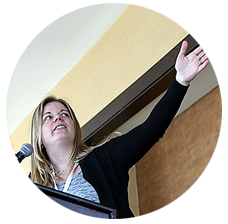By Alex Eng,
Bulletin Correspondent
Company-wide changes in approaches to advertising sales, content, and culture led to the success of the Record-Journal of Meriden, Conn., two company executives told an audience at the New England Newspaper and Press Association winter convention.
The Record-Journal increased its revenue and digital audience growth by 53 and 40 percent, respectively, after making a few fundamental shifts through programs dubbed Revolution 2015 and Opportunity 2016.
The basic premise of those programs was to involve the entire company in devising innovative methods for the newspaper to capture more digital engagement and revenue, according to a presentation titled “Record-Journal’s Revolution 2015.”
Liz White, the Record-Journal’s executive vice president and assistant publisher, and Shawn Palmer, its senior vice president and chief revenue officer, made the presentation Saturday, Feb. 25, to 30 people in the Boston Marriott Long Wharf hotel.
“Low-hanging fruit to us (were) some things that would increase audience engagement,” White said. “Once we started experimenting with (content) digitally, we saw people engaging with (digital content) more.”
Reporters and editors posted on social media more frequently, and the Record-Journal worked on publishing more engaging content online, such as real-time, breaking police news and photo galleries of property transfers. The staff also began experimenting with alternative story forms such as listicles, and updated the designs of both the Record-Journal’s print paper and website, including a new mobile website.
After those efforts, the Record-Journal’s digital subscriptions increased 11 percent that year, although a large share of the digital market was yet to be captured. Thus, the paper’s Opportunity 2016 initiative sought to involve all levels of employees in generating more digital revenue from page views, native advertising, and video.
On the financial side, the sales staff zeroed in on offering clients comprehensive digital and print ad packages and new kinds of products, including sales promotions, contests, restaurant guides, job recruitment postings, and programmatic ads based on users’ preferred content. Salespeople were instructed to pursue prospects based on profitability, and they were held accountable by way of having their numbers posted on a publicly viewed whiteboard in the office for all to see.
The company also formed the newly branded Homebase Digital, a digital advertising interface intended to show clients that the RJ Media Group, which owns both the Record-Journal and The Westerly (R.I.) Sun, is not just a newspaper company but also a serious digital advertising business offering new products such as website development, search engine marketing, social media promotions, and video ads, Palmer said.
“We are doing things a lot differently and thinking differently about how we do it, and about ourselves, and how we position our business moving forward in the future,” Palmer said. “We did a lot of great things. We threw a lot of things at the wall, and we figured out what worked and what didn’t work.”
One thing that didn’t work, for example, was a short-lived foray last year into marketing video production, which the company moved on from quickly as part of its new company culture, White said.
“We celebrate our successes and we get excited, but some things don’t work and you have to acknowledge that they’re failures and move on quickly,” White said.
“Failing fast” became a joke around the Record-Journal office, which physically underwent some major changes that accompanied the paper’s change toward becoming a dynamic, experimental, and modern organization, White said. The Record-Journal sold and moved out of an office building that was more than 100 years old and had multiple floors that severely affected internal communications.
Its newly leased office space is more compact, places all employees on one floor, and features energizing design and branding as well as a ping-pong table, White said.
“Everything you see in our space is designed to make it easier for people to communicate,” White said. “We want people to see when they walk into that space that (they’re) not in a dying newspaper. You’ll know you’re in a new and innovative company that is excited about its future.”
To guide them on their new changes, the paper’s executives devised what they call “transformation spectrums” to help quantify how the paper is doing in sales and content. For example, the sales staff is measured on a scale that determines how the print sales and digital sales teams work independently of each other. Similarly, the content scale determines the proportions of content published either in print or digital-first.
Since its Revolution 2015 program, the Record-Journal was named one of Editor & Publisher Magazine’s 2016 “10 Newspapers that do it right” and won first place for Best Local Website in the 2017 Local Media Digital Innovation Awards, national awards given by the nonprofit Local Media Association.
White said the company’s changing culture was a way of viewing new challenges in the newspaper industry as opportunities for future growth.
“I’m afraid every day, but I’m also inspired and excited by the challenge and the opportunity of it all,” White said. “If we don’t change fast enough, then we’re not going to be able to capture that opportunity.”
MANAGEMENT

‘We are doing things a lot differently and thinking differently about how we do it, and about ourselves, and how we position our business moving forward in the future. We did a lot of great things. We threw a lot of things at the wall, and we figured out what worked and what didn’t work.’
—Shawn Palmer, Senior vice president,
chief revenue officer, Record-Journal, Meriden, Conn.

‘We celebrate our successes and we get excited, but some things don’t work and you have to acknowledge that they’re failures and move on quickly.’
—Liz White, Executive vice president, assistant publisher,
Record-Journal, Meriden, Conn.

‘Everything you see in our space is designed to make it easier for people to communicate. We want people to see when they walk into that space that (they’re) not in a dying newspaper. You’ll know you’re in a new and innovative company that is excited about its future.’
—Liz White

